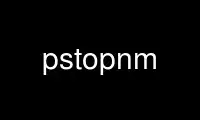
This is the command pstopnm that can be run in the OnWorks free hosting provider using one of our multiple free online workstations such as Ubuntu Online, Fedora Online, Windows online emulator or MAC OS online emulator
PROGRAM:
NAME
pstopnm - convert a PostScript file into a portable anymap
SYNOPSIS
pstopnm [-stdout] [-forceplain] [-help] [-llx s] [-lly s] [-landscape] [-portrait]
[-nocrop] [-pbm |-pgm |-ppm] [-urx s] [-ury s] [-verbose] [-xborder n] [-xmax n] [-xsize
f] [-yborder f] [-ymax n] [-ysize n] psfile[.ps]
DESCRIPTION
Reads a PostScript file as input. Produces PBM, PGM, or PPM files as output. This
program simply uses GhostScript to render a PostScript file with its PNM device drivers.
If you don't have GhostScript installed (invoked by a gs command), or the version you have
installed was not built with the relevant PNM device drivers, pstopnm will fail. You can
see if you have the proper environment by issuing the command gs --help . If it responds
and lists under "Available Devices" pbm, pbmraw, pgm, pgmraw, pnm, pnmraw, ppm, or ppmraw,
you're in business.
pstopnm does not use the Netpbm libraries to generate the output files, so may not be
entirely consistent with most Netpbm programs.
psfile[.ps] is the name of the input file. .pstopnm will add the ps to the end of the
name you specify if no file exists by the exact name you specify, but one with added does.
Use - to indicate Standard Input.
If you use the -stdout option, pstopnm outputs images of all the pages as a multi-image
file to Standard Output. Otherwise, pstopnm creates one file for each page in the
Postscript document. The files are named as follows: If the input file is named
psfile.ps, the name of the files will be psfile001.ppm, psfile002.ppm, etc. The filetype
suffix is .ppm, .pgm, or .pbm, depending on which kind of output you choose with your
invocation options. If the input file name does not end in .ps, the whole file name is
used in the output file name. For example, if the input file is named psfile.old, the
output file name is psfile.old001.ppm, etc.
Note that the output file selection is inconsistent with most Netpbm programs, because it
does not default to Standard Output. This is for historical reasons, based on the fact
that the Netpbm formats did not always provide for a sequence of images in a single file.
Each output file contains the image of a rectangular part of the page to which it
pertains. The selected area will always be centered in the output file, and may have
borders around it. The image area to be extracted from the PostScript file and rendered
into a portable anymap is defined by four numbers, the lower left corner and the upper
right corner x and y coordinates. These coordinates are usually specified by the
BoundingBox comment in the PostScript file header, but they can be overridden by the user
by specifying one or more of the following options: -llx, -lly, -urx, and -ury. The
presence and thickness of a border to be left around the image area is controlled by the
use of the options -xborder and -yborder. If pstopnm does not find BoundingBox parameters
in the input, and you don't specify image area coordinates on the command line, pstopnm
uses default values. If your input is from Standard Input, pstopnm does not use the
BoundingBox parameters (due to the technical difficulty of extracting that information and
still feeding the file to Ghostscript), so you either have to specify the image area
coordinates or take the default.
Unless you specify both output file width and height, via the -xsize and -ysize options,
pstopnm maps the document into the output image by preserving its aspect ratio.
It has been reported that on some Postscript Version 1 input, Ghostscript, and therefore
pstopnm, produces no output. To solve this problem, you can convert the file to
Postscript Version 3 with the program ps2ps. It is reported that the program pstops does
not work.
OPTIONS
-forceplain
forces the output file to be in plain (text) format. Otherwise, it is in raw
(binary) format. See pbm(1), etc.
-llx bx
selects bx as the lower left corner x coordinate (in inches).
-lly by
selects by as the lower left corner y coordinate (in inches).
-landscape
renders the image in landscape mode.
-portrait
renders the image in portrait mode.
-nocrop
does not crop the output image dimensions to match the PostScript image area
dimensions.
-pbm -pgm -ppm
selects the format of the output file. By default, all files are rendered as
portable pixmaps (ppm format).
-stdout
causes output to go to Standard Output instead of to regular files, one per page
(see description of output files above). Use pnmsplit to extract individual pages
from Standard Output.
-urx tx
selects tx as the upper right corner x coordinate (in inches).
-ury ty
selects ty as the upper right corner y coordinate (in inches).
-verbose
prints processing information to stdout.
-xborder frac
specifies that the border width along the Y axis should be frac times the document
width as specified by the bounding box comment in the PostScript file header. The
default value is 0.1.
-xmax xs
specifies that the maximum output image width should have a size less or equal to
xs pixels (default: 612).
-xsize xsize
specifies that the output image width must be exactly xs pixels.
-yborder frac
specifies that the border width along the X axis should be frac times the document
width as specified by the bounding box comment in the PostScript file header. The
default value is 0.1.
-ymax ys
specifies that the maximum output image height should have a size less or equal to
ys pixels (default: 792).
-ysize ys
specifies that the output image height must be exactly ys pixels.
Use pstopnm online using onworks.net services
